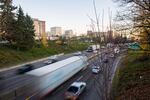Opponents of the $500 million Interstate 5 freeway project in the heart of Portland dominated a public hearing Tuesday night on the proposal’s environmental impact.
Related: I-5 Expansion In Portland Faces Opposition, Unanswered Questions
Critics associated with the group "No More Freeways" charged that an environmental assessment prepared by the Oregon Department of Transportation failed to accurately assess the traffic and pollution impacts of adding lanes to a key stretch of I-5 near the Rose Quarter.
“If you build a city for cars and traffic, all you get is cars and traffic,” said Portland resident Tim Davis, one of some 200 people who attended the hearing at the Oregon Convention Center.
ODOT officials defended their study – and the project. It would add auxiliary lanes along a stretch of I-5, roughly from the Fremont Bridge to the Marquam Bridge in a highly congested corridor that intersects two other freeways.
The environmental assessment released in February predicts sizable reductions in travel times along the mile-long corridor by the year 2045 over what would happen if the project doesn’t go forward. At the same time, the report says, it would improve safety while having a slightly beneficial effect in reducing air pollution.

Interstate 5 runs through the Rose Quarter in Portland, Oregon, Thursday, Dec. 7, 2017.
Bradley W. Parks / OPB
Opponents dispute the agency on every count. Portland economist Joe Cortright, an influential critic of the project, said a similar widening project on I-5 just south of the Columbia River never produced a reduction in crashes. And he charged that ODOT failed to provide enough data in its new environmental assessment to show how the agency reached favorable conclusions.
“They’ve come up with conclusions that are essentially opposed to all scientific literature on traffic congestion,” he said.
Megan Channell, the project manager for ODOT, said it is reviewing a request from No More Freeways to provide additional data on its projections. She said the agency’s findings are based on standard practices for estimating traffic loads.
However, the two sides fundamentally disagree on how to model the impact of adding those auxiliary lanes.
Related: Why Traffic On This Spot On I-5 Near Tacoma Is Always Terrible
Opponents say it will act like other freeway widening projects that wind up spurring more traffic.
“Any expansion of capacity induces traffic,” said Cortright. “It invites more cars. And then you end up right back where you started.”
Cortright and other opponents argue that the state should immediately move to put tolls on the freeway, which they say is a much more effective way to reduce congestion.
“If we have any backbone,” said Katy Wolf, chair of the Boise Neighborhood Association, “we should be telling ODOT to be putting a hard pause on [the project] while we wait for congestion pricing to take effect.”
Channell noted that the state is moving forward to seek federal permission to study tolling on I-5 and I-205. But she said that’s separate from this project, which she argued would not encourage more vehicle usage.
“It’s not inducing demand on the system,” she said in an interview. “It’s making it easier for drivers to merge and weave between three interstates where they don’t have that safe space to do so today.”
The project also includes a number of local street improvements intended to improve both vehicle and bicycle travel, as well as conditions for pedestrians. And there would be caps over the freeway near the Rose Center that supporters say is aimed at knitting together the neighborhood on both sides of 1-5.
But many opponents dismissed the improvements as minor in scale. Among other things, they say the project fails to provide relief for students at Harriet Tubman Middle School, which is next to I-5.
Instead, they argue, the $500 million would be much better spent on a variety of transit and road improvements around the city. Several pointed to major Portland boulevards controlled by ODOT – such as 82nd Avenue on the east side – that have much more significant safety problems, including traffic fatalities.
But ODOT’s Channell noted that the Legislature directed the agency to move forward with a project to reduce traffic congestion on I-5 in the Rose Quarter area.
It’s one of three big freeway projects included in a landmark 2017 transportation package. The others involve new lanes on Highway 217 in Washington County and on Interstate 205 as it goes through Oregon City and West Linn.
The lion’s share of the project’s funding – an estimated $420 million -- would come from the higher gas taxes and other levies contained in that 2017 legislation. Channell said her agency is still working with federal and local partners to come up with the rest of the financing.
Related: What Oregon's Cap-And-Trade Legislation Can’t Buy
Portland Commissioner Chloe Eudaly, who oversees the city’s transportation bureau, sat in on the hearing. And at one point she said that “as much as I would like to spend a half a billion elsewhere” she can’t do so because “it’s ODOT’s money.”
In his own testimony, Cortright urged Eudaly to push the Legislature to reallocate that money to other uses.
Aaron Brown, who heads No More Freeways, said there’s an urgency to act more decisively to help head off global warming.
“We’re out of time,” he said. “I understand that there are political realities. There are physics realities. There is only so much carbon that we can put in the atmosphere.”
Several defenders of the project did testify. Officials representing construction and trucking interests spoke about the value of the project. Owen Ronchelli, executive director of the transportation management association for the Lloyd District, said his group supported the project because it would improve the flow of traffic throughout his area and its livability.
ODOT hopes to begin construction on the project as early as 2023. It could then take four or five years to complete, Channell said.